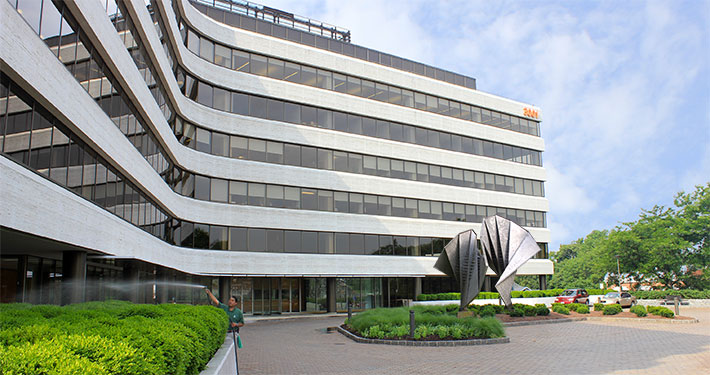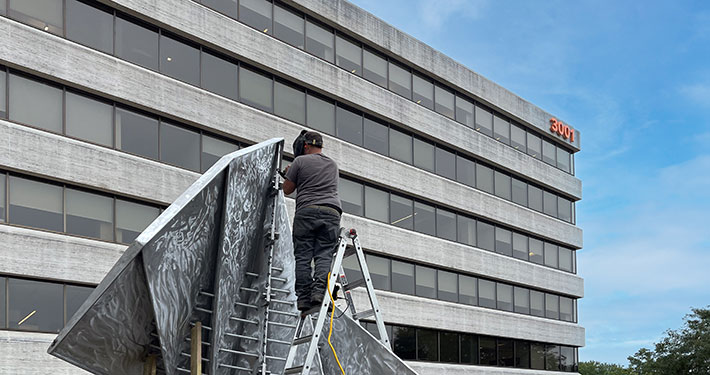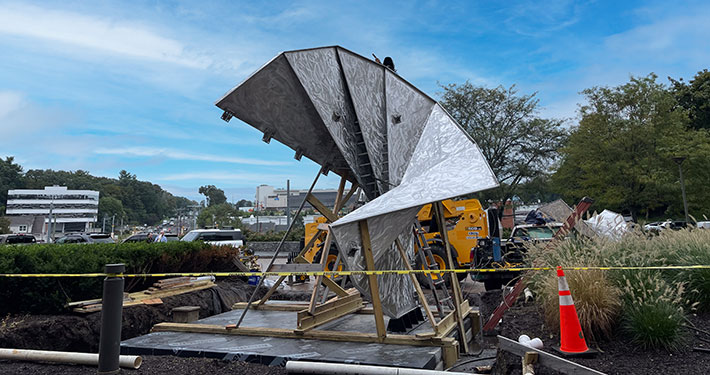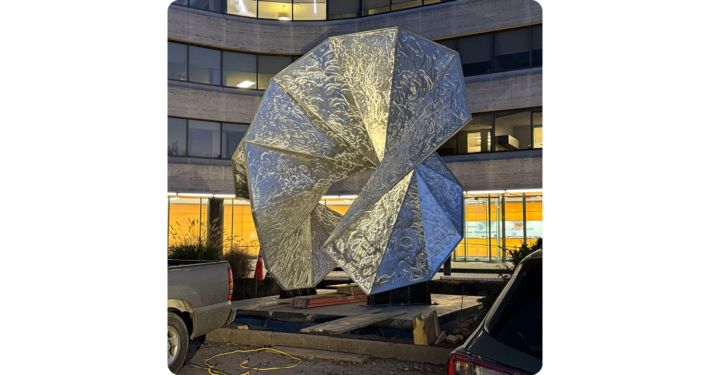The Ashforth Company announced the outdoor sculpture Searching for Peace by Luis Arata, which was gifted to the Town of Greenwich and has been on display as part of the collection of the Greenwich, CT-based Bruce Museum for over 40 years, was recently moved to a new location. The sculpture is now on loan to The Ashforth Company and is located at its 3001 Stamford Square building on Summer Street in Stamford, CT.
Arata’s Searching for Peace, created in 1980, is an 18’ x 18’ x 18’ double fan shape composed of triangular polished aluminum plates. The spiraling abstract modern art sculpture resembles billowing sails on a tall ship or an unfolded oriental fan.
“The recent expansion of the Bruce Museum and addition of the William L. Richter Art Wing regrettably encroached on the area surrounding Searching for Peace and limited the public’s ability to view and experience this significant work. We are very pleased that we could partner with The Ashforth Company to find a new site for Searching for Peace where it will continue to inspire hope and possibility for new audiences,” said Robert Wolterstorff, The Susan E. Lynch Executive Director & CEO.
Prior to the relocation, the 6,000-pound sculpture underwent a complete restoration by Versteeg Art Fabrication, based in Bethany, CT, which included the arduous task of disassembling it in Greenwich, moving it to Bethany to be restored and polished, moving it back down to Stamford, and reassembling it on-site.
“In the initial stages, we faced the formidable challenge of relocating this massive solid aluminum sculpture. However, we came up with an innovative solution for a welded bracket system, which enabled us to dismantle the artwork into four manageable parts for transportation and subsequently reassemble it at its new location. We are truly honored to have been a part of the journey that has given Searching for Peace a prominent new home where it can be admired for many more decades,” said Emily Versteeg, owner of Versteeg Art Fabrication.
Searching for Peace is a non-objective sculpture, which means that it does not depict any specific object or person. Instead, it is up to the viewer to interpret the meaning of the sculpture. Some viewers see the sculpture as a representation of the human spirit searching for peace and harmony. Others see it as a symbol of hope and resilience in the face of adversity. Whatever its interpretation, Searching for Peace is a powerful and moving sculpture that has resonated with viewers for decades. It is a reminder that the search for peace is a universal human experience.
“We are thrilled to be able to provide a new home for Searching for Peace. Viewing original art both inside and outside buildings can have uplifting effects. In choosing art, Ashforth strives to create a look that is eye-catching, inspiring, and fun for those who enter the building each day,” said Darrell Harvey, Executive Chair of The Ashforth Company.
Recently Ashforth learned that an employee of one of their tenants was quite familiar with Searching for Peace as a child. “This sculpture has come full circle for me. I probably should not admit this but when I was a kid, I spent hours climbing all over this sculpture which was near a playground I frequented. I’m ecstatic that I can see it again daily when I’m at work. While I’m sure it will be challenging for me, I promise, I will try to keep myself from going out there to climb it again,” quipped Duncan Lee, Assistant Relationship Manager at First County Bank, a tenant at 3001 Stamford Square.
Searching for Peace was gifted by the Howmet Aluminum Corporation to the Town of Greenwich in 1980, after which it was accessioned into the Bruce Museum’s permanent collection. Howmet had its corporate headquarters at 475 Steamboat Road across the street from the Bruce Museum where the sculpture was displayed until its recent relocation.
Arata (1915-2009) was a Uruguayan American sculptor born in Montevideo, Uruguay. He moved to the United States in 1947 to continue his studies and then lived and worked in New England for the rest of his life. Arata’s sculptures are abstract and non-objective but often express themes of peace, harmony, and the human condition.









